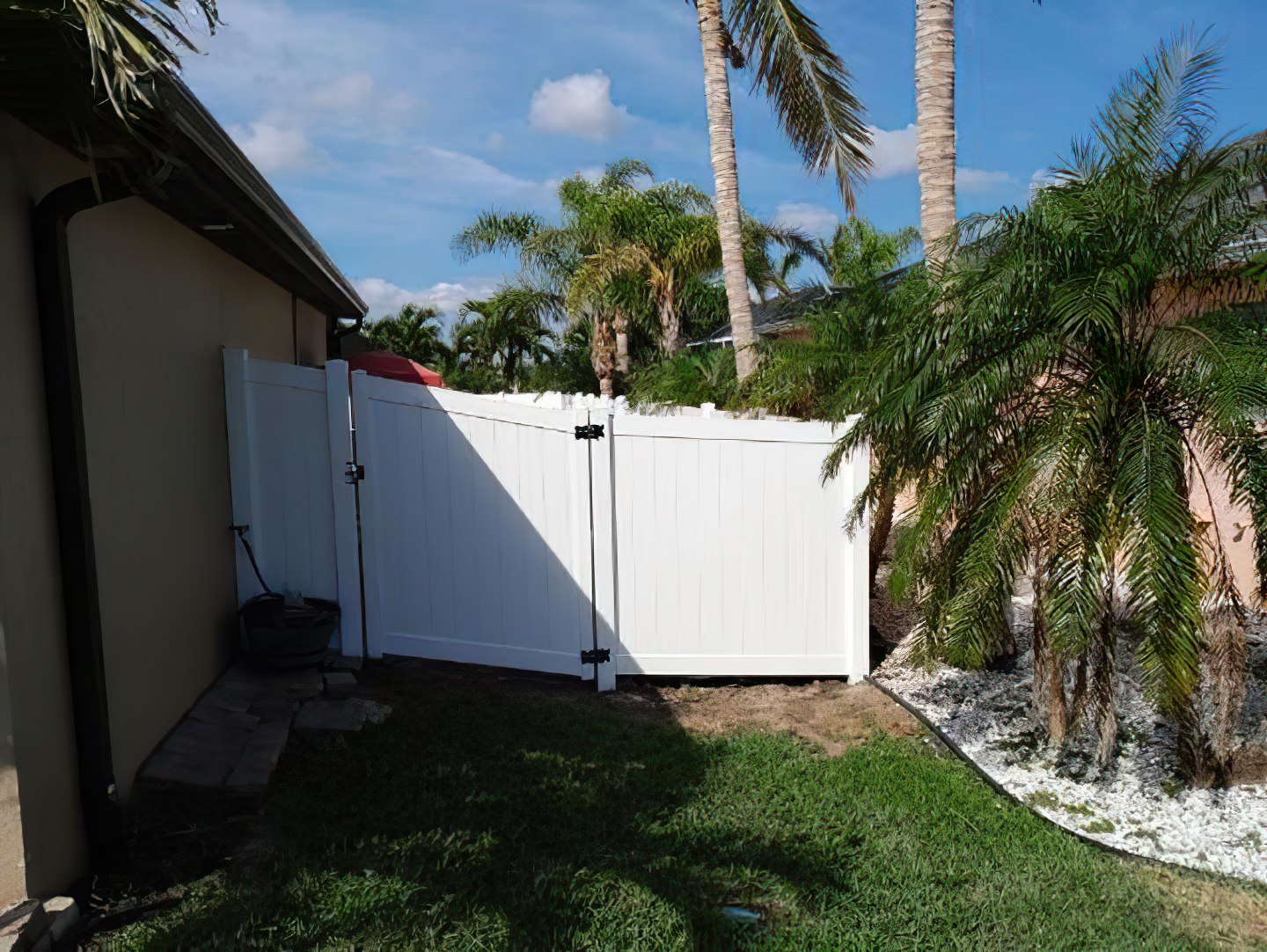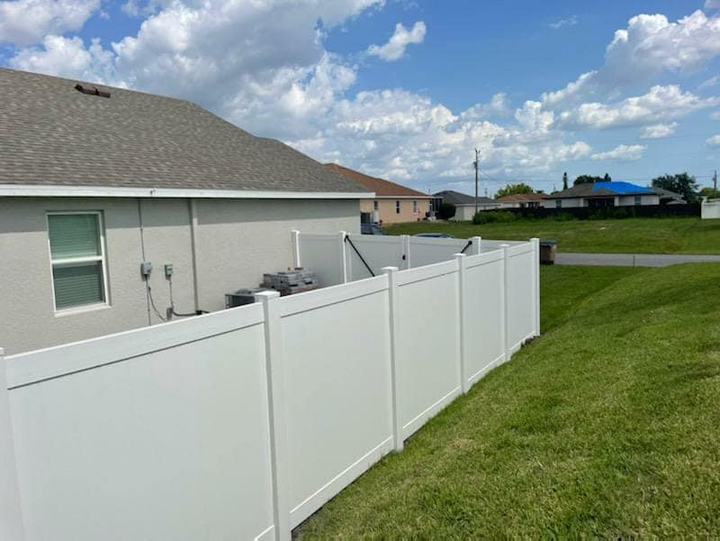Garden fencing is pivotal in yard design, serving practical and aesthetic purposes. It defines property…

Understanding Fence Material Lifespan: How to Extend Its Longevity
Hey there, wood fence owners! Specifically those of you with elegant cedar fences. If you want to ensure your fence stands strong and beautiful for years, you’ve come to the right place. Preserving your fence is not just about looks; it’s a wise investment that saves you money in the long run by preventing undue deterioration. In this article, we’ll explore practical tips and techniques to extend the lifespan of different fence materials, including the application of wood preservatives. Let’s dive in and give your fence the love and care it deserves!
Assessing Your Fence’s Current Condition
Before diving into preservation methods, assessing your fence’s current condition is essential. Grab your magnifying glass and inspect every nook and cranny. Look out for common issues such as rot, cracks, rust, loose components, and telltale signs of mold or vine growth at the base that could harm your wood fence’s health. Please take notes and snap photographs during the inspection, as this will help you track progress and identify areas needing attention.
Cleaning and Preparing the Fence
Cleanliness is key when it comes to preserving your fence. A clean surface allows preservation treatments to penetrate effectively, enhancing their longevity. The cleaning process differs slightly for wooden, metal, and vinyl fences. Be aware of your sprinklers while cleaning, as they can deposit minerals that harm your fence’s integrity. Here’s a step-by-step guide for each:
Wood Fences
- Start by removing debris, loose dirt, and pesky vines with a stiff brush.
- Use a pressure washer or garden hose to rinse the fence. Adjust your sprinklers so they don’t hit the fence directly to avoid water-related deterioration.
- Mix a mild detergent with water and scrub the fence gently with a soft brush.
- Rinse thoroughly and let it dry completely before applying any preservatives.
Metal Fences
- Remove rust and old paint using a wire brush or sandpaper.
- Wash the fence with soapy water and a sponge, paying attention to any mold at the base.
- Rinse off the soap, and ensure the fence is dry before proceeding, especially around the base where water may pool.
Vinyl Fences
- Rinse the fence with a hose to remove surface dirt.
- Create a cleaning solution using water and mild detergent.
- Wipe down the fence using a soft cloth or sponge.
When cleaning your fence, opt for eco-friendly solutions to minimize environmental impact.
Now that your fence is squeaky clean, it’s time to choose the perfect preservative to keep it in top-notch shape. If you’re dealing with a cedar wood fence, consider using a specific wood preservative that prevents deterioration and extends the life of your investment. There are various options, such as stains, paints, sealants, and oils. Each type has its advantages and disadvantages.
Choosing the Right Fence Preservative
Stains penetrate wood, enhancing its natural beauty while protecting it from UV rays and water.
- Paints provide a wide range of color options, adding a vibrant touch to your fence. However, they might require more maintenance.
- Sealants form a protective layer on wood, shielding it from moisture and mold and preventing decay.
- Oils nourish and protect wooden fences, increasing their resistance to weathering.
- Consider factors such as climate, fence material, and your desired level of maintenance when selecting the best preservative for your fence.
You’ve chosen the right preservative; now it’s time for the application process. The correct application ensures the preservative performs its magic effectively. Be sure to treat the base of the fence thoroughly, as this area often experiences the most exposure to harmful elements.
Proper Application Techniques
Start with a clean fence surface for optimal adhesion.
- Apply the preservative evenly using a brush, roller, or sprayer, depending on the product.
- Avoid oversaturating the fence, which might lead to drips and uneven coating.
- Check the manufacturer’s instructions for drying times and recoating recommendations.
- Wear appropriate safety gear and work in a well-ventilated area when handling preservatives.
Preserving your fence continues after a one-time application. Regular maintenance is the key to a long-lasting fence. Set up a seasonal maintenance schedule to ensure you stay on top. Ensure your sprinklers are not indirectly causing sustained dampness on your fence, leading to faster deterioration.
Regular Maintenance Practices
Inspect for winter damage, clean the fence, and retouch the preservative if needed.
Spring, Summer, Fall, & Winter
Check for any signs of wear due to sun exposure, and touch up the preservative if required.
Prepare the fence for winter by removing leaves and debris to prevent moisture buildup.
Protect your fence from snow and ice damage by keeping it clear of snow piles.
Routine maintenance extends your fence’s lifespan and saves you from major repair costs.
Weatherproofing Strategies
Weather can take a toll on your fence, especially in harsh climates. Protect your fence from extreme conditions using these weatherproofing strategies:
Wooden Fences
Apply a waterproof sealant or weatherproofing stain to repel moisture and prevent rot. Pests and rot are a fence’s worst enemies, but fear not! We have some tricks up our sleeves to keep them at bay.
Metal Fences
Coat the fence with rust-resistant paint to shield it from corrosion caused by rain and humidity.
Vinyl Fences
Vinyl is naturally weather-resistant, but you can use UV-resistant coatings to enhance its longevity.
Preventing Pest Infestations and Rot
Using a traditional method, treating the wood with anti-rot solutions can effectively protect it from decay caused by moisture. You can also add an extra layer of protection by painting or applying a wood stain to enhance its natural beauty while safeguarding it from harmful elements.
Common Pests
Identify common fence destroyers like termites, ants, and fungi. Take proactive measures to prevent infestations.
Wooden Fences
Throughout the year, make it a habit to inspect your fence regularly. Check for any signs of wear and tear, especially in areas more exposed to the elements. Look for loose boards, protruding nails, or signs of water damage, such as warping or rotting fence posts. Promptly address any issues you discover to prevent them from escalating and causing more significant problems.
Different fence materials have distinct properties and require specific care. Understanding the unique characteristics of your fence material will help you tailor your preservation efforts accordingly. For instance, sealing or painting fence posts is crucial when dealing with wooden fences.
Wooden fences add a warm and rustic charm to any property but are vulnerable to rot and decay due to moisture and lack of proper sealing. Choose preservatives with fungicides as an ingredient to protect against rot. Additionally, opt for water-repellent preservatives to prevent water damage.
Keep an Eye on Problematic Areas
Metal fences, especially iron, and steel, are susceptible to rust. Regularly inspect the surface for signs of rust, and apply rust-resistant paints or coatings as needed.
Know Your Fence Material
Different fence materials have distinct properties and require specific care. Understanding the unique characteristics of your fence material will help you tailor your preservation efforts accordingly:
Wood Fences
Wooden fences add a warm and rustic charm to any property but are vulnerable to rot and decay. Choose preservatives with fungicides to protect against rot. Additionally, opt for water-repellent preservatives to prevent water damage.
Metal Fences
Metal fences, especially iron, and steel, are susceptible to rust. Regularly inspect the surface for signs of rust, and apply rust-resistant paints or coatings as needed.
Vinyl Fences
Vinyl fences are relatively low-maintenance but can become discolored over time due to sun exposure. Apply UV-resistant coatings to keep them looking vibrant and fresh.

DIY vs. Professional Help
Preserving your fence is a task you can take on yourself, but knowing when to call in the professionals is essential. If you need more confidence in your DIY skills or if your fence requires extensive repairs, it might be best to seek the expertise of a fence preservation specialist. Professional help ensures the job is done correctly, giving your fence the best chance at a long and healthy life.
Community Effort
If you live in a neighborhood where fences are common, consider engaging your neighbors in fence preservation efforts. When multiple fences in the area are well-maintained, it creates a cohesive and appealing neighborhood aesthetic. Share preservation tips and resources, and even organize a fence maintenance day where everyone pitches in to ensure all fences are in top-notch condition.
Sustainable Practices
While preserving your fence, take the opportunity to embrace sustainable practices. Choose eco-friendly and biodegradable preservation products, and consider repurposing or recycling old fence materials if you plan a replacement. Sustainable preservation benefits the environment and contributes to your property’s health and beauty.
Document Your Efforts
Keep a journal or digital record of your efforts throughout the preservation process. Take “before” and “after” pictures, jot down the products you used, and document the dates of your maintenance tasks. This record will help you stay organized and provide valuable insights into what works best for your fence type and local climate.
Share Your Experience
Preserving your fence can be a rewarding and educational journey. Share your experience with friends, family, and the wider community. You might inspire others to embark on fence preservation adventures and contribute to a more visually appealing and sustainable neighborhood.
FAQs
How often should I apply preservatives to my fence?
The frequency of applying preservatives depends on the climate and the product used. In general, most fences benefit from reapplication every 2 to 3 years.
Can I mix different types of preservatives?
It’s not recommended to mix preservatives, as they may have different chemical compositions that could lead to undesirable results.
Can I paint or stain a metal or vinyl fence?
You can paint or stain metal fences using appropriate products designed for metal surfaces. Staining is not recommended for vinyl fences, but you can paint them with vinyl-safe paint.
Conclusion
Preserving your fence is an investment that pays off in the long run. You can significantly extend your fence’s lifespan by assessing its condition, choosing the right preservative, and practicing regular maintenance. Weatherproofing and pest prevention strategies add an extra layer of protection. Follow these tips and give your fence the TLC it deserves, and it’ll stand tall and proud for years to come! Happy preserving!
Remember, these are just guidelines, and it’s always essential to follow manufacturer instructions and use proper safety preca””utions when handling fence preservation products. Enjoy the process, and your fence will thank you with years of reliable service and lasting beauty. Now go forth and make your fence the envy of the neighborhood!




